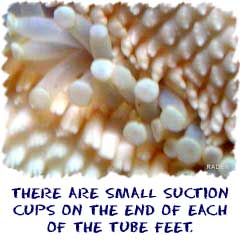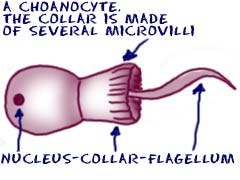
Sponges - The First Invertebrates
Sponges are kind of like the exception to the rules of invertebrates. They are so basic that they have not developed many of the characteristics you might think of when you think of animals. Most sponges are found in seawater, only a few in fresh water. You may have even seen a couple around your bathtub! The ones around your bathtub might look like sponges but they are usually man made. When we talk about sponge structure, remember all the holes. They are very important.Stages of Life
 There are two basic forms in the life cycle of a sponge. Most sponges live their lives attached to a reef. They don't move around. There was a time in their lives when they were little larvae that they were swimming around the water all by themselves. The word larva is another way to describe them when they are babies. Baby sponges don't look like adult sponges, so scientists use another word. Once the larvae land on a piece of rock, they take root (so to speak) and that's that, forever anchored.
There are two basic forms in the life cycle of a sponge. Most sponges live their lives attached to a reef. They don't move around. There was a time in their lives when they were little larvae that they were swimming around the water all by themselves. The word larva is another way to describe them when they are babies. Baby sponges don't look like adult sponges, so scientists use another word. Once the larvae land on a piece of rock, they take root (so to speak) and that's that, forever anchored.
Sponges are really just a bunch of specialized cells working together to help the entire organism survive. Sponges do not have nervous systems, so they don't react to the world around them. Sponges are in the shape of a big "U." On the outside of the U are protective cells, but on the inside are these very special cells with little flagella (wildly whipping tail structures). Those flagella are constantly moving and keeping the water circulating inside of the sponge. Water is sucked in through holes/pores in the side of the sponge. We told you to remember the holes. When the water moves through the sponge, tiny food particles are filtered out of the water by the flagella. Then the water gets pushed out of the sponge through a hole called an osculum. That's basically the life of a sponge. Suck the water in, filter out the food, and send the water out.
The Choanocyte
 The entire life of a sponge revolves around one type of cell. We already told you about flagella. Those flagella are part of a cell called a choanocyte. It's a cell that has three basic parts: flagella, collar, and cell body. Sponges use the flagella to move when they are larvae. The flagella and collar work together to gather food. Sponges even use the choanocyte when it's time to reproduce. Wow! It's a really busy cell.
The entire life of a sponge revolves around one type of cell. We already told you about flagella. Those flagella are part of a cell called a choanocyte. It's a cell that has three basic parts: flagella, collar, and cell body. Sponges use the flagella to move when they are larvae. The flagella and collar work together to gather food. Sponges even use the choanocyte when it's time to reproduce. Wow! It's a really busy cell.
Related Video...
Why the Shark Needs the Sponge (BBC Video)
Encyclopedia.com (Porifera):
http://www.encyclopedia.com/topic/Porifera.aspx
Wikipedia:
http://en.wikipedia.org/wiki/Sponge
Encyclopædia Britannica:
http://www.britannica.com/EBchecked/topic/560783/sponge



